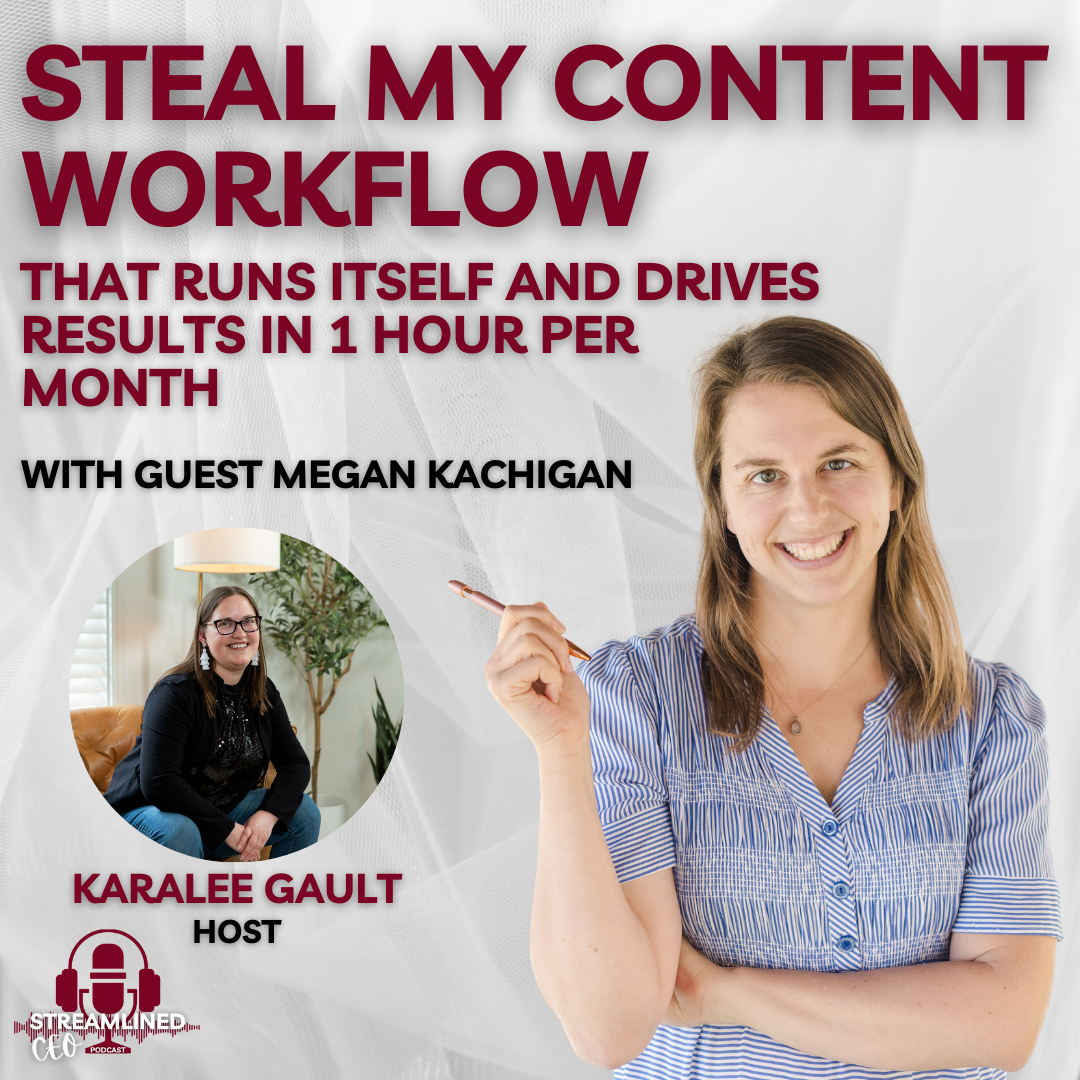Want to write faster emails? Forget templates, stop waiting or scrolling for inspiration, and no more trying to write the perfect email. All of these things that are supposed to be helping you are actually slowing you down. I wrote five sales emails in under an hour—and they converted. I hear too many business owners spending 2 hours writing one email or one post, so today I’m going to share how I do it so much faster with email writing productivity.
The one thing that all of my multi-6 and 7-figure DFY clients have in common is that they ALL send emails to their list regularly (at least weekly). Email marketing is the backbone of how they nurture, connect, and convert. Writing good emails quickly is one of the most important skills you can develop as a business owner.
Write 1 Month of Emails To Your Subscribers – In Less Than An Hour!
A couple months ago, I set a challenge for myself: batch write my weekly emails in one hour per month. I surprised myself and have been on average writing five emails in 55 minutes. The first week I wrote 3 emails in 30 minutes. So I’m averaging about one email every 10 minutes for my own business from scratch (and they’ve already sold!).
Tracking my time like this has been a fun way to keep my focused during my writing hours. Does anyone else do this? Just me? 😂
If you’re wondering how I did it, I’ll walk you through exactly what worked for me to write quickly and effectively. The best part? You can replicate this process, even if you’re dealing with mom brain, distractions, or a packed schedule (because same). Do this as you are writing your holiday and end-of-year sales copy. Your email writing productivity is about to get an overhaul. Here’s how I pulled it off.
Step 1: Set a Clear Intention (and Accountability)
Before I even opened my laptop, I got specific about my goal. I wasn’t just writing random emails—I wanted to batch emails promoting my Copy Critique Club. Having this clarity was my first boost in email writing productivity.
Next, I joined a co-working call and told everyone exactly what I planned to accomplish. Declaring my intentions held me accountable. Every time a distraction popped up (the laundry needs to be folded! That clutter needs to be put away!), I knew I was on the clock to write these emails and everything else could wait. Accountability made it easier to stay focused and productive.
Step 2: Separate Writing From Editing
One of the biggest time-wasters when writing is editing while you write. You know the drill—backspacing sentences, rewriting the same paragraph three times, agonizing over whether a sentence sounds “just right.” I didn’t do any of that.
Instead, I focused on getting my thoughts out of my head and onto the page. Editing would come later. By separating writing from editing, I stopped overthinking and let the words flow. Editing while writing is like cooking while doing the dishes—it’s slowing you down (and quite honestly, it just doesn’t make sense). Make the first draft ugly. This simple mindset shift significantly improved my email writing productivity.
Step 3: Stop Overthinking
Here’s where ChatGPT came in clutch—but not in the way you might think. I didn’t ask it to write my emails for me. Instead, I used it as a brainstorming tool to spark ideas.
I fed ChatGPT the sales page copy for my offer, a few stories I’d already written, and a brief description of my brand voice. Then, I asked it to outline three different email angles for promoting Copy Critique Club. ChatGPT gave me ideas, but I chose the one that resonated most and tweaked it to fit my message. Having all of my ideas narrowed down helped me stop overthinking it all and just let my message flow.
Because this is the internet, let me be clear: I don’t let ChatGPT write for me. Every word in my emails comes from my heart and my thoughts. ChatGPT is simply a tool—a brainstorming partner that helps me explore different angles. It doesn’t replace my creativity or authenticity, and it shouldn’t replace yours either.
When used with intention, ChatGPT can save time and spark ideas. But it’s still up to you to bring your unique voice and message to the table.
This process reassured me that I’d considered all the angles, while still keeping the copy authentic and in my voice. ChatGPT didn’t replace my creativity—it kept me focused instead of getting stuck in my head. Using AI thoughtfully can add a valuable layer to your email writing productivity.
Step 4: Get Specific About the Outcome
I didn’t just sit down and say, “I’m writing emails today.” I had a clear, measurable outcome: five emails promoting Copy Critique Club. I even broke it down further: one email per week for the rest of the month.
This specificity gave me a roadmap. Instead of wondering what to write next, I knew exactly what I needed to create. Clear goals are a cornerstone of email writing productivity.
Step 5: Prepare Ahead of Time
Preparation was key. Before my writing session, I gathered everything I needed:
- My sales page copy
- Stories I wanted to reference
- Notes on my ideal audience and their pain points
I keep a running list on the notes app on my phone of things I want to talk about. I reverse engineer those stories to connect to my CTA. Having all of this ready meant I could dive straight into writing without wasting time hunting for information. Preparedness is a simple but powerful way to boost your email writing productivity.
Step 6: Create the Right Environment
I protect my time and environment for full focus / no distractions during this time. I take one minute to make my desk clutter-free, I had a cozy blanket on my lap, and my water bottle within reach. I made sure I had a quiet place with no distractions in sight. For you, it might be lighting a candle or turning on a playlist that helps you focus. The point is to create an environment that supports your email writing productivity.
Step 7: Focus on One Email at a Time
Once I started writing, I tackled one email at a time. I didn’t let myself think about the next email until I’d finished the current one. This single-tasking approach kept me from feeling overwhelmed and allowed me to fully focus on the message I wanted to convey.
Step 8: Trust the Process
Here’s the thing about writing: your brain will try to convince you that it’s not good enough. Thoughts like, “This isn’t going to resonate,” or, “What if no one likes this?” might pop up. They did for me.
When that happened, I reminded myself to trust the process. The goal was to get the words out, not to write a masterpiece on the first try. Editing would refine the emails later.
Step 9: Edit and Delegate
Once the initial writing is done, then I add in subject lines, hooks, CTAs, and links. I don’t worry about those things during the writing process. They come out at the end. After I read through each one out loud, then I tag my VA to schedule it in my email service provider. This saved me from getting bogged down in scheduling tasks and allowed me to focus where my brain needs to focus.
Why This Email Writing Productivity Process Works (Even With Mom Brain)
As a mom of two littles, my brain often feels pulled in a million directions. Writing five emails in under an hour felt like an impossible task at first—even for someone who does this for a living! But by following this process, I made it happen. The key? Knowing your message really well, having a streamlined workflow (instead of operating from “inspiration”) and focusing on email writing productivity.
Knowing your message as a business owner is like having a well-worn trail through the forest—it gives you a clear path to follow, cutting down on the time you’d spend second-guessing or wandering off course. Here’s how it helps you write faster:
1. Clarity Eliminates Overthinking
When you’re crystal clear on your core message, you don’t waste time wondering what to say or how to say it. You already know your key themes, tone, and values. This focus means you can sit down and dive straight into writing instead of getting bogged down in brainstorming.
2. Consistent Voice Saves Mental Energy
Your message defines your voice and style. With these guidelines in place, you don’t have to re-invent the wheel every time you write. It’s easier to draft content because you’re working within a framework that already feels natural.
3. Your Audience Feels Clearer
When your message is well-defined, you know exactly who you’re speaking to and what they need to hear. This eliminates guesswork, allowing you to tailor your writing to your ideal client’s struggles, desires, and questions right away.
4. Pre-Defined Themes and Stories
A strong message usually includes key stories, metaphors, or examples that resonate with your audience. Having these in your back pocket means you can plug them into your writing without starting from scratch.
5. Streamlined Editing
Knowing your message gives you a clear barometer for what fits and what doesn’t. This makes self-editing much faster because you can quickly eliminate anything that strays from your purpose.
By anchoring your writing in a clear, well-articulated message, you free yourself from the mental clutter and emotional overwhelm of figuring it all out on the spot. The result? Faster drafts, sharper content, and more time to focus on the big-picture work you love.
Why Email Writing Productivity Matters for Your Business
Writing faster isn’t just about saving time. It’s about freeing up mental space for the other things that matter in your business and life. For me, that’s spending time with my kids, serving my clients, and showing up as the best version of myself.
By mastering a process like this, you can create content that connects with your audience, drives sales, and builds your business—all while boosting your email writing productivity.
If you want to experience this process in action, let’s write your copy together during a Power Hour. You tell me what needs to be written (your sales page, an email sequence, your website, you name it), I send you my Starter Gdoc (literally how I start writing for my multi-6 and 7-figure DFY clients), you brain dump on the Gdoc then we meet on Zoom and start writing in flow together. These sessions are so much fun. And a typical response at the end of these sessions is “wow, I feel like I am a much better copywriter now seeing how you think in real time.” And the ROI of these sessions can look like $6000 from 6 emails like in this case study from episode 9.
Writing copy doesn’t have to feel overwhelming or time-consuming. With the right process, it can even be fun. So, what are you waiting for? Set your timer, grab your favorite drink, and start writing. Your email writing productivity will thank you.




